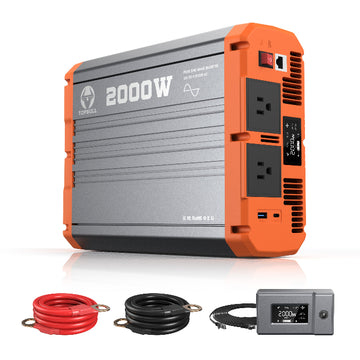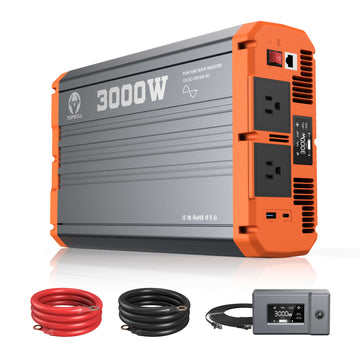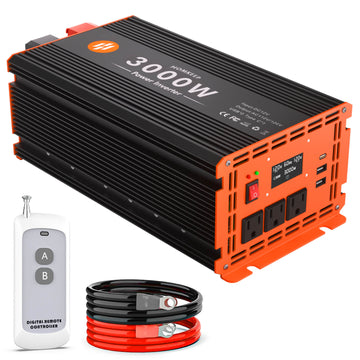Installing a power inverter in a truck is essential for drivers who need reliable AC power on the road. Whether you're a long-haul trucker, an off-grid traveler, or someone who wants to power essential devices, a truck inverter converts DC power from your battery into usable AC power.
This guide will walk you through choosing the right truck inverter, setting up the wiring, and installing it correctly. Read on, install your power inverter, and enjoy uninterrupted power wherever your journey takes you!
You May Also Need:
Best Inverter for Truck: Detailed Review and Expert Tips
How Much Does A Power Inverter Cost: Smart Buying Tips
Before Truck Inverter Installation: Preparations
1. Choose the Right Power Inverter for Your Truck
Selecting the right power inverter for your truck requires understanding both your power consumption needs and your truck's battery capacity. Here's how to choose a suitable power inverter for your vehicle.
Make Sure to Pick the Right Inverter Size for a Truck
To select the right inverter, first calculate the total wattage of the devices you'll use simultaneously. An undersized inverter can cause overloads, while an oversized one may waste energy and drain your battery. Here's a quick guide:
- 1000W Inverter – Ideal for small electronics like laptops, smartphones, camera batteries, and LED lights.
- 2000W Inverter – Suitable for small kitchen appliances (e.g., coffee makers, mini-fridges) and medium-duty tools like power drills.
- 3000W–4000W Inverter – Required for high-power appliances, such as microwaves, electric cookers, power saws, and portable air conditioners.
Be sure to check the starting (surge) wattage of your devices, as some appliances temporarily draw double their rated power when turned on.
Best Truck Inverters: Topbull Power Inverter
For a reliable and durable power solution, Topbull power inverters provide high efficiency and stable performance for truckers. Here are three Topbull inverter models, each designed for different power demands:
-
Topbull 2000W Power Inverter: Ideal for mid-range power needs, such as laptops, small kitchen appliances, and mini-fridges.
-
Topbull 3000W Power Inverter: Great for larger appliances and power tools, making it a versatile option for truckers.
- Topbull 4000W Power Inverter: A heavy-duty choice that can handle multiple high-power devices simultaneously, perfect for truckers needing maximum power output.

2. Find the Best Location for the Truck Inverter
Ideally, mount the inverter close to the battery to minimize power loss and maximize wiring efficiency. However, avoid placing it near heat sources like the engine or exhaust, as excessive temperatures can lead to overheating. Additionally, secure the inverter properly to prevent damage from vibrations or road movement, which is especially important for long-haul truckers.
Step-by-Step Guide to Truck Inverter Installation
Now, let's move on to installing the power inverter in your truck. Before you start, make sure to follow these safety precautions:
- Park your truck on a stable surface and engage the parking brake.
- Turn off the ignition and disconnect the battery to avoid electrical hazards.
- Have the necessary tools ready (wrenches, screwdrivers, fuses, and proper gauge cables).
Step 1. How to Wire a Power Inverter in a Truck
Proper wiring is critical for safety and performance. Follow these steps carefully:
-
Use the correct gauge cables: The higher the inverter wattage, the thicker the cable is needed to handle the current flow.
-
Connect the positive (red) cable from the inverter to the truck battery's positive terminal.
-
Connect the negative (black) cable from the inverter to the battery's negative terminal or a solid chassis ground.
- Keep cables as short as possible: This reduces resistance and improves efficiency.
Note: Never connect the inverter to the truck's cigarette lighter socket for high-power applications, or it cannot handle high current loads.
Step 2. Installing Fuses and Circuit Protection for a Truck Inverter
To protect your inverter and truck's electrical system, always install a fuse or circuit breaker. An inline fuse should be placed on the positive cable as close to the battery as possible to prevent damage from electrical surges.
The fuse rating depends on the inverter size, for example, a 2000W inverter typically requires a 200A fuse. For additional safety, a circuit breaker is a great option, especially when running power-hungry appliances.
Step 3. Securely Mount the Truck Power Inverter
Once everything is wired, securely mount the inverter to a solid surface using brackets or screws. A loose installation can cause excessive vibrations, leading to wire disconnections or even component failure.
Also, ensure that the inverter has enough ventilation space to dissipate heat efficiently and prevent performance issues.
Step 4. Testing the Power Inverter in Your Truck
Before using the inverter, run a quick test to ensure it's working correctly:
-
Reconnect the truck battery and double-check all connections.
-
Turn on the inverter and check the indicator lights.
-
Plug in a low-power device (e.g., a phone charger) to verify operation.
- Gradually test higher-power appliances to ensure stability.
If the inverter fails to power on, recheck your wiring, fuse, and battery condition.
Common Problems and Fixes for Truck Power Inverters
Truck power inverters, like any piece of equipment, can encounter issues over time, like overloads, overheating, etc. In the following sections, we'll cover some of the most frequent issues truck inverter users face and provide practical solutions to address them.
How to Fix Overload Issues in a Truck Inverter
If your truck inverter is constantly overloaded, it can affect performance and even damage the system. To resolve this, consider the following steps:
-
Reduce the Number of Devices Connected: If your inverter is overloaded, try disconnecting some devices to lighten the load.
- Upgrade to a Higher Wattage Inverter: If you keep running into overload issues, consider upgrading to an inverter with a higher wattage to support more devices.
Now that you've addressed potential overload issues, it's equally important to prevent overheating, another common challenge with truck inverters.
How to Prevent Truck Power Inverter Overheating
Overheating is a major concern for truck inverters, but there are simple steps you can take to avoid it:
-
Make Sure There's Proper Ventilation: Place your inverter in a spot with good airflow to prevent it from getting too hot.
- Don't Run It at Full Capacity for Long Periods: Running the inverter at maximum load for extended periods can cause it to overheat. Try to avoid pushing it too hard.
Tips: If you encounter more problems when using a power inverter, please check out: Common Inverter Failures and Their Solutions
Maintenance Tips for a Long-Lasting Truck Power Inverter
Regular maintenance also plays an equally important role in ensuring its longevity and optimal performance. By taking a few simple steps to maintain your inverter, you can avoid unexpected issues and extend its lifespan. Let's explore some key maintenance tips to keep your inverter in top shape for the long haul.
How to Properly Maintain a Truck Inverter
To keep your truck's power inverter running smoothly, regular maintenance is key:
-
Check and Tighten Connections: Vibrations can loosen connections, so check and tighten them periodically to avoid performance issues or damage.
-
Keep the Inverter Clean: Dust and debris can clog vents and affect airflow. Clean it regularly with a cloth or compressed air to prevent overheating.
- Ensure Proper Ventilation: Place the inverter in a well-ventilated area and ensure vents are not blocked to avoid overheating.
Best Practices for Using a Truck Power Inverter
To optimize your inverter's performance and lifespan, follow these best practices:
-
Avoid Overloading: Don't exceed the inverter's power capacity to prevent damage. Refer to the manual for load limits.
-
Use the Right Cable Size: Use cables of the correct size to ensure safe and efficient power transfer.
-
Turn Off When Not in Use: Switch off the inverter when not needed to save battery life and prevent wear.
- Charge the Battery Regularly: Keep the battery fully charged to ensure proper inverter function and prevent power issues.
Conclusion
Installing a power inverter in your truck enhances your ability to use electronic devices and appliances on the road. You can ensure a reliable power source whenever needed by choosing the right inverter, wiring it correctly, and following maintenance tips. For top-quality inverters, consider Topbull power inverters have a range of 2000W, 3000W, and 4000W models, and offer excellent performance for various truck applications. Stay powered and stay safe on the road!













